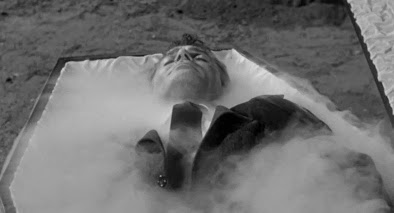The Return of Dracula is mostly interesting as an early attempt (it came out in 1958) to bring the vampire into a contemporary setting. Aside from that it’s a fairly routine by-the-numbers low-budget vampire flick obviously aimed at the drive-in market.
The vampire (we assume he’s Dracula although he’s never named) decides that eastern Europe in the 50s is not the place to be, a sentiment no doubt shared by most of the population of eastern Europe at that time. He’s decided he wants some California sunshine, which is a bit odd given that he’s a vampire. He murders another would-be refugee on a train and takes his identity. Then he shows up in the small town of Carleton California, claiming to be Bellac Gordal, a long-lost relative of the Mayberry family. Nobody in the family has seen Bellac since he was a kid so the deception is pretty easy to carry off.
It’s soon obvious that Cousin Bellac is a bit odd. He tends not to show up at meal times and he disappears fairly regularly. The Mayberrys assume that his sufferings in communist Hungary have made him somewhat anti-social so they don’t worry too much at first.
The first major sign of trouble is the sudden and mysterious death of a blind girl named Jenny. The audience knows that she’s the vampire’s first victim but no-one in the town knows that.
It comes as no surprise to the audience when the young and beautiful Rachel Mayberry starts looking a bit pale and complains about feeling rather tired. Rachel had been initially rather taken by Cousin Bellac’s European sophistication and old world charm. This will soon take on sinister implications.
The rest of the plot follows the standard course for a Dracula movie without adding anything particular new or original. The vampire has vampirised one young woman and obviously has his sights on his next victim who will obviously be Rachel.
This wasn’t the first attempt to transplant Dracula to American soil. Universal had already done that in 1943 with their excellent and very underrated Son of Dracula. Universal opted for a setting in the American South and went all out with the southern gothic vibe. That worked very successfully. Landing Dracula in California is in some ways a bolder move but it presents obvious challenges that The Return of Dracula doesn’t quite succeed in meeting. The incongruity of a middle European vampire running about in an idyllic 1950s vision of small-town America does work up to a point. And the movie does succeed in capturing the occasional gothic mood.
The acting is quite competent with Francis Lederer making a reasonably effective vampire. He mixes charm and menace with some success. Norma Eberhardt is unfortunately a slightly bland heroine.
Of course there has to be a vampire hunter. One expects this to be a van Helsing type character. John Merriman (John Wengraf) coms across as basically that type but oddly he’s a European policeman. Having Dracula hunted by a cop is an interesting touch.
This movie was clearly intended as drive-in fodder and the budget was obviously fairly minimal. Director Paul Landres does an acceptable job within those constraints.
By this time this movie was released it had already become hopelessly outdated due to the appearance of the first couple of Hammer gothic horror movies. The Hammer movies not only looked infinitely better with vastly superior production values they were also simply much better movies in every department. They were also a whole lot scarier. It definitely has to be admitted that The Return of Dracula is a bit lacking when it comes to actual scares.
One plus is the merciful lack of comic relief, an annoying feature that horror film-makers were finally starting to dispense with.
MGM released this movie in their Midnite Movies range, paired with another movie, The Vampire, made a year earlier with the same director and the same screenwriter. Both movies have been given very fine anamorphic transfers. Neither movie could be described as a classic but if you can pick up the disc fairly cheaply it’s a reasonably fun double-feature.
The Return of Dracula is mildly entertaining but don’t expect too much.





No comments:
Post a Comment